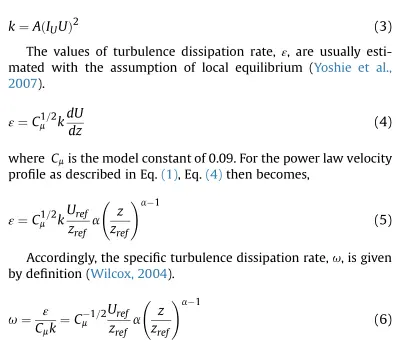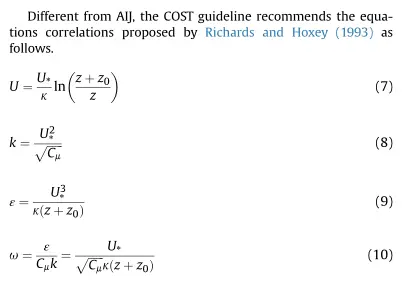建筑风环境数值模拟湍流模型选取经验
1、第一篇文献
Improvement of k-epsilon turbulence model for CFD simulation of atmospheric boundary layer around a high-rise building using stochastic optimization and Monte Carlo Sampling technique
尽管经过多年研究,建筑物周围湍流的CFD数值模拟仍然是一个具有挑战性的问题(Lateb等人,2016)。即使对于一个简单的立方体形式的独立建筑,实验结果和CFD预测之间也存在明显的差异。
相关的研究发现,标准k-e模型不能在建筑的顶部产生逆流,改善后的模型如LK k-e(kato,1993),RNG k-e (Yakhot and Orzag,1986),MMK k-e(Tsuchiya,1997)可以更准确地预测流动形态,但标准k-e和改善的k-e模型都高估了建筑后面的再附着距离。
Yoshie et al. (2007), Tominaga and Stathopoulos (2010), Vardoulakis et al. (2011),Gousseau et al.(2011)等人的研究也发现(RANS)湍流模型在再现建筑物后面的弱风区和高估建筑物后面的再附着长度方面的不准确性。
Tominaga (2015),研究了孤立建筑的非定常雷诺平均湍流模型(unsteady Reynolds-averaged Navier– Stokes (URANS) turbulence modeling)的精度,发现 SST k-o能够模拟建筑后方的非定常波动,能够较好的再现建筑后面的速度场,但是该模型高估了拐角处的分离。
先前的研究表明,相比较于LES模型和URANS模型,RANS 湍流模型在预测孤立建筑周围的气流提供了较差的结果。但是LES模型和URANS模型在具体精确的边界条件,合适的网格和时间尺度方面的高度复杂性,以及他们固有的高计算成本,使得它们作为许多实际工程问题的可靠和快速解决方案的潜在应用非常有限。
参考文献
Lateb M, Meroney R N, Yataghene M, et al. On the use of numerical modelling for near-field pollutant dispersion in urban environments− A review[J]. Environmental Pollution, 2016, 208: 271-283.
Kato M. The modelling of turbulent flow around stationary and vibrating square cylinders[J]. Turbulent Shear Flow, 1993, 1: 10.4. 1-10.4. 6.
Yakhot V, Orszag S A. Renormalization group Analysis of turbulence. I. Basic theory[J]. Journal of scientific computing, 1986, 1(1): 3-51.
Tsuchiya M, Murakami S, Mochida A, et al. Development of a new k− ε model for flow and pressure fields around bluff body[J]. Journal of Wind Engineering and Industrial Aerodynamics, 1997, 67: 169-182.
Yoshie R, Mochida A, Tominaga Y, et al. Cooperative project for CFD prediction of pedestrian wind environment in the Architectural Institute of Japan[J]. Journal of wind engineering and industrial aerodynamics, 2007, 95(9-11): 1551-1578
Tominaga Y, Stathopoulos T. Numerical simulation of dispersion around an isolated cubic building: model evaluation of RANS and LES[J]. Building and Environment, 2010, 45(10): 2231-2239.
Vardoulakis S, Dimitrova R, Richards K, et al. Numerical model inter-comparison for wind flow and turbulence around single-block buildings[J]. Environmental Modeling & Assessment, 2011, 16(2): 169-181.
Gousseau P, Blocken B, Van Heijst G J F. CFD simulation of pollutant dispersion around isolated buildings: On the role of convective and turbulent mass fluxes in the prediction accuracy[J]. Journal of Hazardous Materials, 2011, 194: 422-434.
Tominaga Y. Flow around a high-rise building using steady and unsteady RANS CFD: Effect of large-scale fluctuations on the velocity statistics[J]. Journal of Wind Engineering and Industrial Aerodynamics, 2015, 142: 93-103.
2、第二篇文献
RANS model calibration using stochastic optimization for accuracy improvement of urban airflow CFD modeling
一般来说,与LES相比,RANS模型的计算成本要低一个数量级。这使得它们更适合作为设计和分析工具[37](which makes them more suitable tools for design and Analysis purposes.)
城市建筑气流研究中最常用的是两方程模型,包括标准k-e [38]、RNG k-e[39]、可实现k-e[40]和k-o SST[41],针对这些模型,已经有应用指南[42,43]。
RANS模型的一个缺点是,在预测建筑物周围和后面弱风区域的平均流量时,两方程湍流模型的精确度较低[45–48]。总的来说,两方程湍流模型的不准确性部分,是由于湍流粘度假设的简化和湍流动能(TKE)耗散率(ε)的导出方程[49]造成的。湍流粘性假设是在雷诺应力各向异性和平均速度梯度之间存在直接关系的假设下发展起来的,该平均速度梯度类似于牛顿流体中的分子粘性应力。然而,正如参考文献中所讨论的[49],湍流的物理学完全不同于分子过程,分子过程被用来达到牛顿粘性应力定律。另一方面,不可能解决ε的精确传输方程,因为它需要进一步建模和开发经验方程[50]。
RANS家族模型中的闭合方程主要被假设为完全的经验方程,由几个未知系数组成,这些未知系数通过观察少量基本流来近似,包括均匀各向同性衰减湍流、充分发展的渠道流和简单剪切流[49]。尽管如此,这些基本气流和大气边界层中建筑物周围的气流之间还是有一定的相似性。因此,这导致了一系列研究,以校准平坦地形[51]和复杂地形[10]上的大气边界层流动、高层建筑周围的流动[5,53–55]以及街道峡谷内的流动[56,57]的k-ε模型的闭合系数。还考虑了其他湍流模型闭合系数的校准,用于使用Spalart–Allmaras和RNG k-ε模型预测低层建筑上的风压[58],以及使用k-ω SST模型预测建筑块周围的污染扩散[59]。
参考文献
[5] Q.M.Z. Iqbal, A.L.S. Chan, Pedestrian level wind environment assessment around group of high-rise cross-shaped buildings: effect of building shape, separation and orientation, Build. Environ. 101 (2016) 45–63.
[10] H.W. Detering, D. Etling, application of the E-ε turbulence model to the atmospheric boundary layer, Boundary-Layer Meteorol. 33 (1985) 113–133.
[37] B. Blocken, LES over RANS in building simulation for outdoor and indoor applications: a foregone conclusion? Build. Simulat. 11 (2018) 821–870.
[38] B.E. Launder, D.B. Spalding, The numerical computation of turbulent flows, Comput. Methods appl. Mech. Eng. 3 (1974) 269–289.
[39] V. Yakhot, S.A. Orszag, Renormalization-group Analysis of turbulence, Phys. Rev. Lett. 57 (1986) 1722.
[40] T.-H. Shih, W.W. Liou, A. Shabbir, Z. Yang, J. Zhu, A new k-ε eddy viscosity model for high Reynolds number turbulent flows, Comput. Fluids 24 (1995) 227–238.
[41] F.R. Menter, Two-equation eddy-viscosity turbulence models for engineering applications, AIAA J. 32 (1994) 1598–1605.
[42] J. Franke, A. Hellsten, H. Schlünzen, B. Carissimo, Best Practice Guideline for the CFD Simulation of Flows in the Urban Environment. COST Action 732: Quality Assurance and Improvement of Microscale Meteorological Models. Hamburg, Ger, 2007.
[43] Y. Tominaga, A. Mochida, R. Yoshie, H. Kataoka, T. Nozu, M. Yoshikawa, T. Shirasawa, AIJ guidelines for practical applications of CFD to pedestrian wind environment around buildings, J. Wind Eng. Ind. Aerod. 96 (2008) 1749–1761.
[45] A. Mochida, Y. Tominaga, S. Murakami, R. Yoshie, T. Ishihara, R. Ooka, Comparison of various ke models and DSM applied to flow around a high-rise building, Wind Struct. 5 (2002) 227–244.
[46] S. Murakami, R. Ooka, S. Kato, S. Iizuka, A. Mochida, Numerical prediction of flow around a building with various turbulence models: comparison of {kappa}-{var_epsilon} EVM, ASM, DSM, and LES wind tunnel tests, in: American Society of Heating, Refrigerating and Air-Conditioning Engineers, 1996.
[47] T. Shirasawa, A. Mochida, Y. Tominaga, H. Yoshino, Evaluation of turbulent time scale of linear revised κ-ε models based on LES data, Jpn. Wind Eng. Res. J. (JWE) (2006) 125–128.
[48] Y. Tominaga, Flow around a high-rise building using steady and unsteady RANS CFD: effect of large-scale fluctuations on the velocity statistics, J. Wind Eng. Ind. Aerod. 142 (2015) 93–103.
[49] S.B. Pope, Turbulent Flows, 2001.
[50] D.C. Wilcox, Turbulence Modeling for CFD, DCW Industries. Inc 5354, La Canada, California, 1998, pp. 124–128.
[51] P.G. Duynkerke, application of the E-ε turbulence closure model to the neutral and stable atmospheric boundary layer, J. Atmos. Sci. 45 (1988) 865–880.
[53] H. Mittal, A. Sharma, A. Gairola, Numerical simulation of pedestrian level wind conditions: effect of building shape and orientation, Environ. Fluid Mech. (2019) 1–26.
[54] H. Mittal, A. Sharma, A. Gairola, Numerical simulation of pedestrian level wind flow around buildings: effect of corner modification and orientation, J. Build. Eng. 22 (2019) 314–326,
[55] M. Shirzadi, P.A. Mirzaei, M. Naghashzadegan, Improvement of k-epsilon turbulence model for CFD simulation of atmospheric boundary layer around a high-rise building using stochastic optimization and Monte Carlo Sampling technique, J. Wind Eng. Ind. Aerod. 171 (2017),
[56] N. Glover, S. Guillas, L. Malki-Epshtein, Statistical calibration of CFD modelling for street canyon flows, in: Proceedings of Building Simulation 2011: 12th Conference of International Building Performance Simulation Association, International Building Performance Simulation Association (IBSPA), 2011, pp. 1513–1520.
[57] S. Guillas, N. Glover, L. Malki-Epshtein, Bayesian calibration of the constants of the k–ε turbulence model for a CFD model of street canyon flow, Comput. Methods appl. Mech. Eng. 279 (2014) 536–553.
[58] J.M. Gimenez, F. Bre, Optimization of RANS turbulence models using genetic algorithms to improve the prediction of wind pressure coefficients on low-rise buildings, J. Wind Eng. Ind. Aerod. 193 (2019) 103978,
[59] H. Yu, J. Th´e, Validation and optimization of SST k-ω turbulence model for pollutant dispersion within a building array, Atmos. Environ. 145 (2016) 225–238,
3、第三篇文献
Validation and optimization of SST k-u turbulence model for pollutant dispersion within a building array
CFD模拟通常需要高水平的计算资源,并且在验证之前不被认为是准确的(Blocken et al., 2013)。
通过发布综合实践指南支持城市环境中污染物扩散的CFD模拟(Franke et al., 2007; Schatzmann et al., 2010; Tominaga et al., 2008)。
对于复杂建筑环境中污染物扩散的CFD模拟已经有了大量的研究。数值技术主要包括雷诺平均纳维尔-斯托克斯(RANS)方法、大涡模拟(LES)和分离涡模拟(DES)。基于k-ε的RANS模型仍然是模拟复杂城市环境中污染物扩散最常用的模型,因为它兼顾了准确性和计算成本(Lateb et al., 2016; Pontiggia et al., 2010)。
雷诺应力模型(RSM)是另一种用于复杂室外环境的RANS技术(Buccolieri et al., 201 1)。然而,与基于k-ε的模型相比,RSM方法经常产生较差的结果,尽管它花费更多的计算时间(Koutsourakis et al., 2012; Tominaga and Stathopoulos, 2013)。
更多数值参数的优化被认为是性能不佳的原因。The optimization of more numerical parameters was deemed responsible for the inferior performance (Tominaga and Stathopoulos, 2013).
LES本质上比RANS模型更精确,因为它可以捕捉更多的物理特征,包括流动不稳定性和标量的各向异性(Buccolieri et al., 2011)。然而,据报道LES的计算工作量高10-100倍(Cheng et al., 2003)。此外,LES对网格质量和流入条件非常敏感(Xie and Castro, 2009)。
DES是一种混合方法,在靠近墙的区域使用RANS,在自由流中使用LES (Strelets, 2001)。
Kakosimos和Assael (2013年)采用基于SpalarteAllmaras湍流的DES方法模拟建筑阵列的浓度场,并获得了可接受的验证指标。这可能是现有方法的一种有前途的替代方法,但需要进一步的探索。
基于k-ε的湍流模型的大多数缺点是显而易见的。标准的k-ε模型不能一直积分到壁面,并且很难预测湍流产生远大于其耗散的流动。这些类型流动区域包括分离和冲击(Li et al., 2006; Moukalled et al., 2015)。修正的k-ε模型不能捕捉尾流体积和升高位置的信息(the wake volume, and elevated positions)(Lateb et al., 2013; Tominaga and Stathopoulos, 2013)。
尽管近壁处理更好,但据作者所知,k-o闭合模型从未被报道用于污染物扩散,这可能是由于其对自由流的敏感性。Menter提出的剪切应力输运(SST) k-u模型综合了k-ε和k-o模型的优点(Menter, 1993, 1994)。因此,它可能是k-e家族的一个极好的替代品。然而,SST k-o模型方法很少用于模拟城市环境下的污染物迁移(Yu and The, 2016)。更重要的是,各种RANS模式之间的具体比较表明了SST k-o优于同类产品。Daroczy et al. (2015)声明SST k-o和可实现的k-ε模型是模拟H-Darrieus转子的两种合适的RANS模型。Ramponi and Blocken (2012) 明确指出SST k-o模型在建筑物的横向通风的流动模拟中优于其基于k-ε的竞争对手。关于交叉通风模拟的类似结论也被报道by Peren et al. (2015)。
非定常SST k-o模型能够再现高层建筑后面和周围的流动不稳定性,尽管它高估了建筑拐角处的流动分离(Tominaga, 2015)。
SST k-o提供了与更为计算机密集型的DES模拟几乎相同的结果(Yu and The, 2016)。
参考文献
Blocken, B., Tominaga, Y., Stathopoulos, T., 2013. CFD simulation of micro-scale pollutant dispersion in the built environment. Build. Environ. 64, 225e230.
Franke, J., Hellsten, A., Schlünzen, H., Carissimo, B., 2007. Best Practice Guideline for the Cfd Simulation of Flows in the Urban Environment. Brussels, Belgium.
Schatzmann, M., Olesen, H., Frank, J., 2010. COST 732 Model Evaluation Case Studies: approach and Results. University of Hamburg, Hamburg, Germany, p. 122.
Tominaga, Y., Mochida, A., Yoshie, R., Kataoka, H., Nozu, T., Yoshikawa, M., Shirasawa, T., 2008. AIJ guidelines for practical applications of CFD to pedestrian wind environment around buildings. J. Wind Eng. Ind. Aerodyn. 96, 1749e1761.
Lateb, M., Meroney, R.N., Yataghene, M., Fellouah, H., Saleh, F., Boufadel, M.C., 2016. On the use of numerical modelling for near-field pollutant dispersion in urban environments A review. Environ. Pollut. 208, 271e283. Part A.
Pontiggia, M., Derudi, M., Alba, M., Scaioni, M., Rota, R., 2010. Hazardous gas releases in urban areas: assessment of consequences through CFD modelling. J. Hazard. Mater 176, 589e596.
Buccolieri, R., Salim, S.M., Leo, L.S., Di Sabatino, S., Chan, A., Ielpo, P., de Gennaro, G., Gromke, C., 2011. Analysis of local scale treeeatmosphere interaction on pollutant concentration in idealized street canyons and application to a real urban junction. Atmos. Environ. 45, 1702e1713.
Koutsourakis, N., Bartzis, J.G., Markatos, N.C., 2012. Evaluation of Reynolds stress, k-ε and RNG k-ε turbulence models in street canyon flows using various experimental datasets. Environ. Fluid Mech. 12, 379e403.
Tominaga, Y., Stathopoulos, T., 2013. CFD simulation of near-field pollutant dispersion in the urban environment: a review of current modeling techniques. Atmos. Environ. 79, 716e730.
Cheng, Y., Lien, F.S., Yee, E., Sinclair, R., 2003. A comparison of large Eddy simulations with a standard keε Reynolds-averaged NaviereStokes model for the prediction of a fully developed turbulent flow over a matrix of cubes. J. Wind Eng. Ind. Aerodyn. 91, 1301e1328.
Xie, Z.-T., Castro, I.P., 2009. Large-eddy simulation for flow and dispersion in urban streets. Atmos. Environ. 43, 2174e2185.
Strelets, M., 2001. Detached eddy simulation of massively separated flows. In: 39th Aerospace Sciences Meeting and Exhibit. American Institute of Aeronautics and Astronautics.
Kakosimos, K.E., Assael, M.J., 2013. application of Detached Eddy Simulation to neighbourhood scale gases atmospheric dispersion modelling. J. Hazard. Mater 261, 653e668.
Li, X.X., Liu, C.H., Leung, D.Y.C., Lam, K.M., 2006. Recent progress in CFD modelling of wind field and pollutant transport in street canyons. Atmos. Environ. 40, 5640e5658.
Moukalled, F., Mangani, L., Darwish, M., 2015. The Finite Volume Method in Computational Fluid Dynamics: an Advanced Introduction with OpenFOAM and Matlab. Springer International Publishing.
Lateb, M., Masson, C., Stathopoulos, T., Bedard, C., 2013. Comparison of various types of keε models for pollutant emissions around a two-building configuration. J. Wind Eng. Ind. Aerodyn. 115, 9e21.
Menter, F.R., 1993. Zonal two equation kappa-omega turbulence models for aerodynamic flows. In: 24th AIAA Fluid Dynamics Conference. Orlando, Florida, U.S.
Menter, F.R., 1994. Two-equation eddy-viscosity turbulence models for engineering applications. AIAA J. 32, 1598e1605.
Yu, H.S., The, J., 2016. Simulation of gaseous pollutant dispersion around an isolated building using the k-u SST turbulence model. J. Air Waste Manag. Assoc. Accepted.
Daroczy, L., Janiga, G., Petrasch, K., Webner, M., Thevenin, D., 2015. Comparative Analysis of turbulence models for the aerodynamic simulation of H-Darrieus rotors. Energy 90, 680e690. Part 1.
Ramponi, R., Blocken, B., 2012. CFD simulation of cross-ventilation for a generic isolated building: impact of computational parameters. Build. Environ. 53, 34e48.
Peren, J.I., van Hooff, T., Leite, B.C.C., Blocken, B., 2015. CFD Analysis of crossventilation of a generic isolated building with asymmetric opening positions: impact of roof angle and opening location. Build. Environ. 85, 263e276.
Tominaga, Y., 2015. Flow around a high-rise building using steady and unsteady RANS CFD: effect of large-scale fluctuations on the velocity statistics. J. Wind Eng. Ind. Aerodyn. 142, 93e103.



